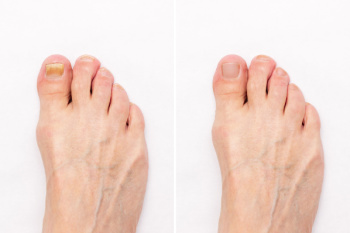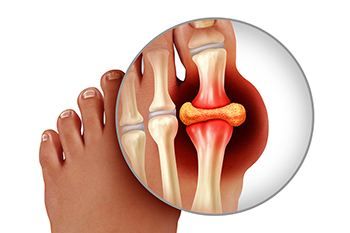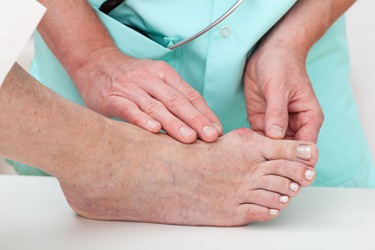Items filtered by date: October 2024
Toenail Fungus Progression and Treatment

Toenail fungus, or onychomycosis, begins as a small white or yellow spot under the nail. As the fungus spreads, the nail can thicken, become discolored, and develop a brittle or crumbly texture. Without treatment, the fungus can worsen, leading to overgrowth, making it difficult to trim nails, and causing discomfort when walking. In severe cases, the nail may separate from the nail bed, increasing the risk of bacterial infection. Signs that toenail fungus is getting worse include increased nail thickening, spreading discoloration, foul odor, and pain. If left untreated, the infection can spread to surrounding skin, causing more severe issues like cellulitis. If you have signs of toenail fungus, it is suggested that you schedule an appointment with a podiatrist for a proper diagnosis and treatment.
For more information about treatment, contact Edward Fryman, DPM, FACFAOM of Seaford Foot Care Center. Our doctor can provide the care you need to keep you pain-free and on your feet.
Toenail Fungus Treatment
Toenail fungus is a condition that affects many people and can be especially hard to get rid of. Fortunately, there are several methods to go about treating and avoiding it.
Antifungals & Deterrence
Oral antifungal medicine has been shown to be effective in many cases. It is important to consult with a podiatrist to determine the proper regiment for you, or potentially explore other options.
Applying foot powder on the feet and shoes helps keep the feet free of moisture and sweat.
Sandals or open toed shoes – Wearing these will allow air movement and help keep feet dry. They also expose your feet to light, which fungus cannot tolerate. Socks with moisture wicking material also help as well.
If you have any questions please feel free to contact our office located in Seaford, and Bethpage, NY . We offer the newest diagnostic tools and technology to treat your foot and ankle needs.
We Can Treat Your Foot or Ankle Pain
What You Eat Can Cause Gout

Gout is a form of arthritis that causes sudden and severe pain, redness, and swelling in the joints, most commonly affecting the big toe. It occurs when uric acid builds up in the bloodstream, forming sharp crystals in the joints. This often leads to intense pain that makes even the lightest touch feel unbearable. Certain foods can trigger gout attacks, particularly those high in purines, which the body converts to uric acid. It is advisable to avoid red meats, organ meats, shellfish, sugary beverages, and alcohol. Instead, focus on a diet rich in fruits, vegetables, and whole grains to help manage uric acid levels. If you are experiencing gout symptoms or have questions about managing this condition, it is important to seek professional guidance. It is suggested you schedule an appointment with a podiatrist to discuss treatment options and preventive strategies, ensuring your feet remain healthy and pain-free.
Gout is a foot condition that requires certain treatment and care. If you are seeking treatment, contact Edward Fryman, DPM, FACFAOM from Seaford Foot Care Center. Our doctor will treat your foot and ankle needs.
What Is Gout?
Gout is a type of arthritis caused by a buildup of uric acid in the bloodstream. It often develops in the foot, especially the big toe area, although it can manifest in other parts of the body as well. Gout can make walking and standing very painful and is especially common in diabetics and the obese.
People typically get gout because of a poor diet. Genetic predisposition is also a factor. The children of parents who have had gout frequently have a chance of developing it themselves.
Gout can easily be identified by redness and inflammation of the big toe and the surrounding areas of the foot. Other symptoms include extreme fatigue, joint pain, and running high fevers. Sometimes corticosteroid drugs can be prescribed to treat gout, but the best way to combat this disease is to get more exercise and eat a better diet.
If you have any questions please feel free to contact our office located in Seaford, and Bethpage, NY . We offer the newest diagnostic and treatment technologies for all your foot and ankle needs.
Stress Fractures of the Foot and Ankle

Stress fractures are small cracks in the bone caused by repetitive stress, often affecting athletes or those who suddenly increase their activity levels. Common symptoms include localized pain that worsens with activity, swelling, tenderness, and sometimes bruising surrounding the affected area. You may also notice pain that eases with rest but returns when you resume activity. Treatment typically involves resting the affected foot or ankle to allow the bone to heal. In more severe cases, a podiatrist might recommend immobilization with a brace or boot to protect the fracture. Gradual return to activity guided by a podiatrist is vital to preventing recurrence. If you suspect a stress fracture or experience persistent foot or ankle pain, it is suggested that you schedule an appointment with a podiatrist. This type of doctor can perform a thorough evaluation and recommend an effective treatment plan to ensure a full recovery.
Activities where too much pressure is put on the feet can cause stress fractures. To learn more, contact Edward Fryman, DPM, FACFAOM from Seaford Foot Care Center. Our doctor can provide the care you need to keep your pain free and on your feet.
Dealing with Stress Fractures of the Foot and Ankle
Stress fractures occur in the foot and ankle when muscles in these areas weaken from too much or too little use. The feet and ankles then lose support when walking or running from the impact of the ground. Since there is no protection, the bones receive the full impact of each step. Stress on the feet can cause cracks to form in the bones, thus creating stress fractures.
What Are Stress Fractures?
Stress fractures occur frequently in individuals whose daily activities cause great impact on the feet and ankles. Stress factors are most common among:
- Runners
- People affected with Osteoporosis
- Tennis or basketball players
- Gymnasts
- High impact workouts
Symptoms
Pain from the fractures occur in the area of the fractures and can be constant or intermittent. It will often cause sharp or dull pain with swelling and tenderness. Engaging in any kind of activity which involves high impact will aggravate pain.
If you have any questions please feel free to contact our office located in Seaford, and Bethpage, NY . We offer the newest diagnostic and treatment technologies for all your foot and ankle needs.
Understanding Causes of Different Areas of Foot Pain

Foot pain can originate from various sources, depending on which part of the foot is affected. Pain in the heel, often attributed to conditions like plantar fasciitis or Achilles tendinitis, can result from excessive stress or inflammation. The ball of the foot may hurt due to metatarsalgia or neuromas, often caused by high-impact activities or wearing poor footwear. Pain in the arch can indicate issues such as flat feet or arch strain. Toe pain, on the other hand, might be due to bunions, hammertoe, or gout, conditions that affect toe alignment or joint health. Each area of the foot can be vulnerable to specific problems, so identifying the precise location and nature of the pain is vital for effective treatment and management, ensuring relief and improved mobility. If you have pain in one or more areas of your foot, it is strongly suggested that you contact a podiatrist who can offer you effective treatment solutions.
Foot Pain
Foot pain can be extremely painful and debilitating. If you have a foot pain, consult with Edward Fryman, DPM, FACFAOM from Seaford Foot Care Center. Our doctor will assess your condition and provide you with quality foot and ankle treatment.
Causes
Foot pain is a very broad condition that could be caused by one or more ailments. The most common include:
- Bunions
- Hammertoes
- Plantar Fasciitis
- Bone Spurs
- Corns
- Tarsal Tunnel Syndrome
- Ingrown Toenails
- Arthritis (such as Gout, Rheumatoid, and Osteoarthritis)
- Flat Feet
- Injury (from stress fractures, broken toe, foot, ankle, Achilles tendon ruptures, and sprains)
- And more
Diagnosis
To figure out the cause of foot pain, podiatrists utilize several different methods. This can range from simple visual inspections and sensation tests to X-rays and MRI scans. Prior medical history, family medical history, and any recent physical traumatic events will all be taken into consideration for a proper diagnosis.
Treatment
Treatment depends upon the cause of the foot pain. Whether it is resting, staying off the foot, or having surgery; podiatrists have a number of treatment options available for foot pain.
If you have any questions, please feel free to contact our office located in Seaford, and Bethpage, NY . We offer the newest diagnostic and treatment technologies for all your foot care needs.
Non-Surgical Treatment for Bunions

Bunions, a bony bump at the base of your big toe, can result from a misalignment of bones and tissues that pushes the toe inward. While surgery is the only way to completely remove a bunion, nonsurgical bunion treatments can effectively manage symptoms and slow progression. Wearing shoes with a wide toe box and low heels can reduce pressure on the bunion. Custom orthotics can help with proper foot alignment. Toe spacers and splints can also relieve discomfort by preventing further misalignment, although they will not permanently correct the bone structure. Stretching exercises may increase flexibility and ease pain, but they will not reverse the bunion itself. If your bunion is causing discomfort, consulting a podiatrist early can lead to treatment options that delay or prevent further complications. If you have pain caused by a bunion, it is suggested that you schedule an appointment with a podiatrist for guidance.
If you are suffering from bunion pain, contact Edward Fryman, DPM, FACFAOM of Seaford Foot Care Center. Our doctor can provide the care you need to keep you pain-free and on your feet.
What Is a Bunion?
Bunions are painful bony bumps that usually develop on the inside of the foot at the joint of the big toe. As the deformity increases over time, it may become painful to walk and wear shoes. Women are more likely to exacerbate existing bunions since they often wear tight, narrow shoes that shift their toes together. Bunion pain can be relieved by wearing wider shoes with enough room for the toes.
Causes
- Genetics – some people inherit feet that are more prone to bunion development
- Inflammatory Conditions - rheumatoid arthritis and polio may cause bunion development
Symptoms
- Redness and inflammation
- Pain and tenderness
- Callus or corns on the bump
- Restricted motion in the big toe
In order to diagnose your bunion, your podiatrist may ask about your medical history, symptoms, and general health. Your doctor might also order an x-ray to take a closer look at your feet. Nonsurgical treatment options include orthotics, padding, icing, changes in footwear, and medication. If nonsurgical treatments don’t alleviate your bunion pain, surgery may be necessary.
If you have any questions, please feel free to contact our office located in Seaford, and Bethpage, NY . We offer the newest diagnostic and treatment technologies for all your foot care needs.

